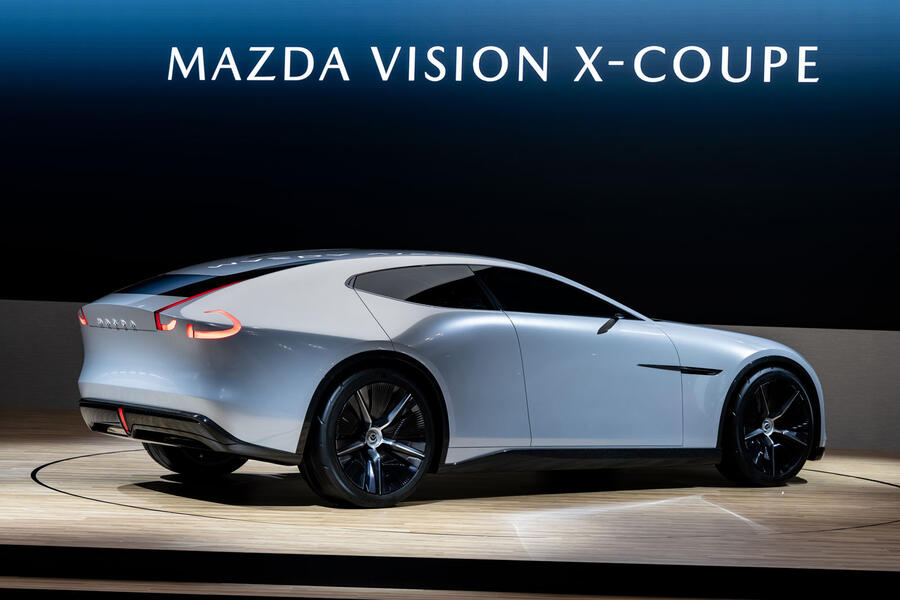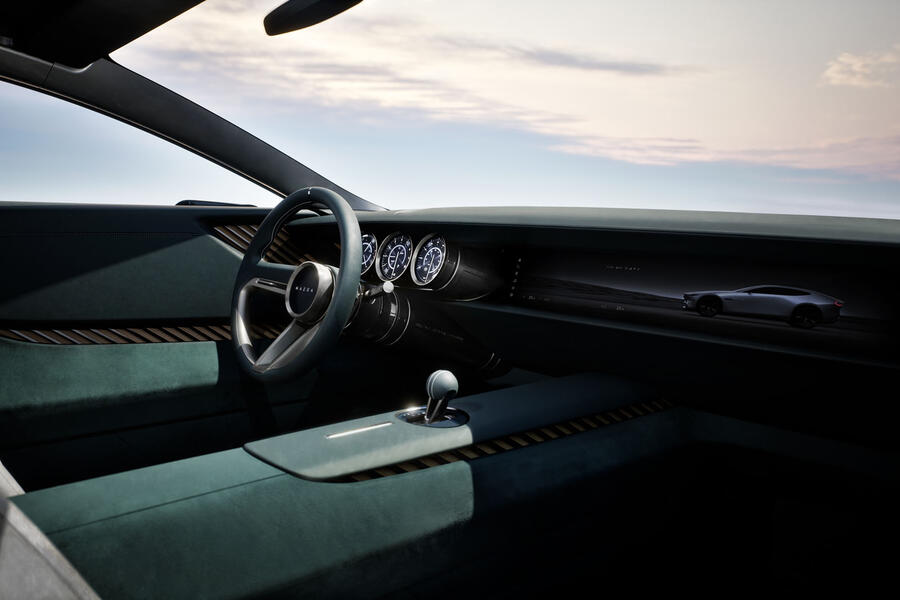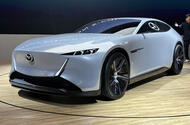Up to 500 miles of combined range for Mazda’s new four-seat sports plug-in hybrid concept
Mazda has revealed a 503bhp sports saloon with a rotary-electric powertrain that promises up to 500 miles of combined range – and is set to feature in a production car in the next three years.
The Vision X-Coupé – star of the brand’s stage at the Tokyo motor show – is a sleek, rakish four-door that’s clearly evolved from the striking Iconic SP sports car concept that Mazda revealed at the Tokyo show two years ago.
It is also, visually and conceptually, evolved from the 2015 RX-Vision concept, which set the tone for the Kodo design language the firm still deploys today and previewed plans for a new rotary-engined powertrain.
The concept uses a turbocharged two-rotor engine as part of a plug-in hybrid system, which is said to be capable of travelling 100 miles with the engine off.
However, unlike in the MX-30 R-EV crossover, which uses a rotary as a generator to top up the battery, this concept’s rotors actually drive the wheels (as they did in the old RX-3, RX-7 and RX-8 coupés).
Launching a production version of this powertrain would be a significant step for Mazda, which is investing heavily in new ways of decarbonising its cars while it gradually builds up to going all-electric.
The firm’s chief technical officer, Ryuichi Umeshita, told Autocar that it could be a landmark “carbon-negative” alternative fuel solution.

“Of course, the battery-EV is a very good solution for going carbon-neutral,” he said. “But what we’ve presented today is that with internal-combustion engines, we can go even further than that to carbon-negative.”
Mazda has been vocal about the potential for synthetic fuels to reduce the environmental impact of combustion engines and has invested in their development while EV uptake has faltered in many of its key markets.
Umeshita explained that because the concept’s rotary engine is designed to run on carbon-neutral fuel, derived from microalgae, it emits 90% less CO2 than a conventional petrol engine – and it is also fitted with a carbon-capture device at the tailpipe which is said to shave another 20% off.
“So theoretically,” he said, “we can reduce by 110%, so that means as you run, you make the earth cleaner.”
“So we can go carbon-negative, which we cannot achieve with the battery-EV. So that is a very unique pathway. I believe the internal combustion engine can make the environment even cleaner than battery EV.”
Umeshita explained that microalgae is also much cheaper and less energy-intensive to produce than synthetic types of alternative fuel. It also has the added benefit of being compatible with existing production engines and fuel station infrastructure, so could in theory be used from today once Mazda works out how to produce it cost-effectively at scale – “and I believe we are very close”.

However, Mazda must still grapple with the inherent increased emissions of a rotary engine compared with a conventional engine. “The vision car has a rotary engine as a drivetrain, not a generator, and in order to realise that, we need good emission levels in a wider range, from low RPM to high RPM.
“That is the next level of development that we need,” Umeshita said, adding that the firm still needs “two to three years” of development time to make it viable.
It’s for that reason that the MX-30 R-EV’s rotary engine isn’t used to drive the wheels directly, instead operating at low revs (remaining within legal emission limits) to charge the battery.
Mazda is investing in a new generation of this engine-generator that will emit less CO2 in the meantime for future range-extender models.
“We have established the Rotary Engine Development Group to develop the next-generation rotary engine, and as of today we do have a very good prospect for that as a generator,” said Umeshita. “We can clear the global emissions, including the US ones. So we are very close to being ready to deploy that.”
Mazda will not necessarily build a production version of the Vision X-Coupé “as it is”, Umeshita said, but “some technologies of it or some design elements will be featured in future Mazda cars.”
Overall, the new concept measures 5050mm long and 1480mm tall, making it the same sort of size as the similarly shaped Polestar 5 and Lotus Emeya.
Showcasing an evolved interpretation of Mazda’s elegant Kodo design language, it features a long, probing bonnet (unlike the rotary-electric Iconic SP concept, which was mid-engined) and a distinctive cab-rear silhouette that bolsters its long-range GT credentials.
Source: Autocar
